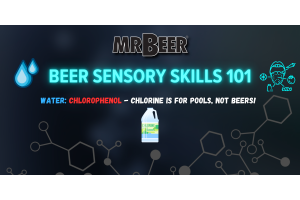Is My Beer Infected?
This is a question that we get quite often so we wanted to provide some information so you can tell if your brew is good or not.
When you are new to brewing the first time you see the fermentation process it can look a little crazy. Each batch you brew will behave and ferment differently than the batch before, so it is possible that your fermentation will always look different. Some people will dump perfectly good beer thinking it has an infection when it does not. So before you decide whether your beer is a dumper, you will want to visually inspect and possibly even taste it to make sure it's still worth keeping or not.
So let's talk about what fermentation looks like. During fermentation you will get foamy bubbles on the top of your beer, this is called krausen and is perfectly normal for brewing. Depending on the batch that you are brewing you may get a very high krausen or a low krausen. Some beers might now show much of krausen at all.
This all depending on what you are brewing, the ingredients you are using, temperature, etc. One way to always check for fermentation is to see if you have any trub build up on the bottom of the fermenter. If you do, then your good to go. So just remember that all fermentations will not look the same.
Okay so now onto how to spot an infection. An oily sheen on top of your beer that may look kind of like thin white ice sheets with jagged edges is a sign of the beginning of an infection. This infection is usually caused by wild yeast such as Brettanomyces or wild bacteria such as lactobacillus.
In some cases, it could be a combination of these or other bacteria/wild yeast. In more advanced infections, this layer of biofilm called a "pellicle" may look very wavy, sort of like ramen noodles. Or it may look like bubbles with webbing coming off it. These are different types of infections, but they are caused by similar bacteria/yeast strains.
A pellicle is only formed in the presence of oxygen and is a way for the wild yeast/bacteria top protect itself from oxygen because they prefer an anaerobic environment. So you can still have an infection even without the pellicle formation if your beer was free of oxygen exposure during fermentation. In this case, the only way to know whether it is infected or not is to taste it.
Don't worry about getting sick because none of these wild bacteria, yeast or mold can harm you. If the beer tastes bad or rancid, you might wanna dump it. But in some cases, an infection can result in a pretty good tasting beer. Keep in mind that sour beers, which are all the rage right now, are brewed with these wild yeasts and bacteria.
If you are brewing with our LBK and you consistently get infections it is possible that it got into some small scratches or the plastic of the fermenter. In this case, we would recommend replacing your fermenter with a new one.
If your beer is infected with mold, which will be fuzzy and discolored (usually green but can be white or brownish – but always fuzzy), this can typically be skimmed off the beer.
Mold only grows on the surface and will not penetrate the beer itself. Mold cannot survive the alcohol in beer. Fortunately, mold usually takes a long time to grow on beer so as long as you're not leaving it in the fermenter for too long, you shouldn't have this issue.
Proper cleaning/sanitizing, and the proper care of your plastic equipment (only soft cloths for cleaning, nothing that can scratch the plastic) will help prevent these types of infection. But always keep in mind that even with the best cleaning and sanitizing procedures in place, you can still get infections from time to time. Don't let this discourage you. Learn from it and keep brewing.





